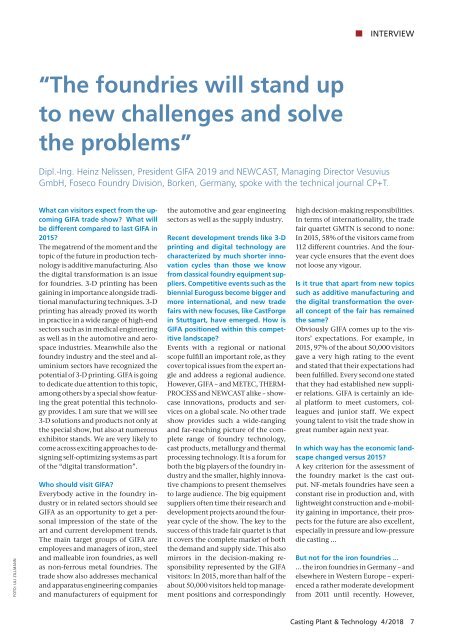CPT International 04/2018
Create successful ePaper yourself
Turn your PDF publications into a flip-book with our unique Google optimized e-Paper software.
INTERVIEW<br />
“The foundries will stand up<br />
to new challenges and solve<br />
the problems”<br />
Dipl.-Ing. Heinz Nelissen, President GIFA 2019 and NEWCAST, Managing Director Vesuvius<br />
GmbH, Foseco Foundry Division, Borken, Germany, spoke with the technical journal CP+T.<br />
FOTO: ULI ZILLMANN<br />
What can visitors expect from the upcoming<br />
GIFA trade show? What will<br />
be different compared to last GIFA in<br />
2015?<br />
The megatrend of the moment and the<br />
topic of the future in production technology<br />
is additive manufacturing. Also<br />
the digital transformation is an issue<br />
for foundries. 3-D printing has been<br />
gaining in importance alongside traditional<br />
manufacturing techniques. 3-D<br />
printing has already proved its worth<br />
in practice in a wide range of high-end<br />
sectors such as in medical engineering<br />
as well as in the automotive and aerospace<br />
industries. Meanwhile also the<br />
foundry industry and the steel and aluminium<br />
sectors have recognized the<br />
potential of 3-D printing. GIFA is going<br />
to dedicate due attention to this topic,<br />
among others by a special show featuring<br />
the great potential this technology<br />
provides. I am sure that we will see<br />
3-D solutions and products not only at<br />
the special show, but also at numerous<br />
exhibitor stands. We are very likely to<br />
come across exciting approaches to designing<br />
self-optimizing systems as part<br />
of the “digital transformation”.<br />
Who should visit GIFA?<br />
Everybody active in the foundry industry<br />
or in related sectors should see<br />
GIFA as an opportunity to get a personal<br />
impression of the state of the<br />
art and current development trends.<br />
The main target groups of GIFA are<br />
employees and managers of iron, steel<br />
and malleable iron foundries, as well<br />
as non-ferrous metal foundries. The<br />
trade show also addresses mechanical<br />
and apparatus engineering companies<br />
and manufacturers of equipment for<br />
the automotive and gear engineering<br />
sectors as well as the supply industry.<br />
Recent development trends like 3-D<br />
printing and digital technology are<br />
characterized by much shorter innovation<br />
cycles than those we know<br />
from classical foundry equipment suppliers.<br />
Competitive events such as the<br />
biennial Euroguss become bigger and<br />
more international, and new trade<br />
fairs with new focuses, like CastForge<br />
in Stuttgart, have emerged. How is<br />
GIFA positioned within this competitive<br />
landscape?<br />
Events with a regional or national<br />
scope fulfill an important role, as they<br />
cover topical issues from the expert angle<br />
and address a regional audience.<br />
However, GIFA – and METEC, THERM-<br />
PROCESS and NEWCAST alike – showcase<br />
innovations, products and services<br />
on a global scale. No other trade<br />
show provides such a wide-ranging<br />
and far-reaching picture of the complete<br />
range of foundry technology,<br />
cast products, metallurgy and thermal<br />
processing technology. It is a forum for<br />
both the big players of the foundry industry<br />
and the smaller, highly innovative<br />
champions to present themselves<br />
to large audience. The big equipment<br />
suppliers often time their research and<br />
development projects around the fouryear<br />
cycle of the show. The key to the<br />
success of this trade fair quartet is that<br />
it covers the complete market of both<br />
the demand and supply side. This also<br />
mirrors in the decision-making responsibility<br />
represented by the GIFA<br />
visitors: In 2015, more than half of the<br />
about 50,000 visitors held top management<br />
positions and correspondingly<br />
high decision-making responsibilities.<br />
In terms of internationality, the trade<br />
fair quartet GMTN is second to none:<br />
In 2015, 58% of the visitors came from<br />
112 different countries. And the fouryear<br />
cycle ensures that the event does<br />
not loose any vigour.<br />
Is it true that apart from new topics<br />
such as additive manufacturing and<br />
the digital transformation the overall<br />
concept of the fair has remained<br />
the same?<br />
Obviously GIFA comes up to the visitors’<br />
expectations. For example, in<br />
2015, 97% of the about 50,000 visitors<br />
gave a very high rating to the event<br />
and stated that their expectations had<br />
been fulfilled. Every second one stated<br />
that they had established new supplier<br />
relations. GIFA is certainly an ideal<br />
platform to meet customers, colleagues<br />
and junior staff. We expect<br />
young talent to visit the trade show in<br />
great number again next year.<br />
In which way has the economic landscape<br />
changed versus 2015?<br />
A key criterion for the assessment of<br />
the foundry market is the cast output.<br />
NF-metals foundries have seen a<br />
constant rise in production and, with<br />
lightweight construction and e-mobility<br />
gaining in importance, their prospects<br />
for the future are also excellent,<br />
especially in pressure and low-pressure<br />
die casting ...<br />
But not for the iron foundries ...<br />
... the iron foundries in Germany – and<br />
elsewhere in Western Europe – experienced<br />
a rather moderate development<br />
from 2011 until recently. However,<br />
Casting Plant & Technology 4/ <strong>2018</strong> 7

















